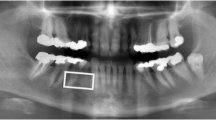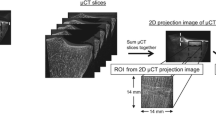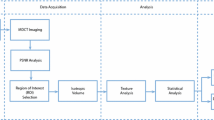Abstract
Introduction
Alteration of bone trabecular architecture is a predictor of fracture risk in osteoporosis. Until now, microarchitecture can only be measured on a bone biopsy, thus limiting microarchitecture analysis in routine clinical practice for osteoporosis. Texture analysis on X-ray images has been advocated to be a suitable means to assess two-dimensional (2-D) microarchitecture in the research field. But little is known about the relationships between three-dimensional (3-D) architecture and texture analysis, particularly in clinical practice. The purposes of the study were: (1) to explore the relationship between 3-D histomorphometric parameters and 2-D texture analysis, and (2) to see if cortical assessment may influence results.
Methods
In this study, the anterosuperior part of the iliac bone was removed from 24 cadavers. Large samples were prepared and comprised of the crest and a strip of bone approximately 3 cm wide and 5 cm long. These large specimens were used in order to preserve bone architecture; they also corresponded to the location used by histomorphometrists for the diagnosis of metabolic bone diseases on iliac crest biopsies. Bone samples were examined with a microcomputed tomograph for 3-D microarchitecture [BV/TV, C.BV/C.TV, Tb.Pf, structure model index (SMI), Tb.Th, Tb.N, Tb.Sp]. Texture analysis was done by several methods (skeletonization, run lengths, fractal techniques) from X-ray projection images. No correlation was found between bone mass parameters (BV/TV and C.BV/C.TV, which take into account both cortical and trabecular bone) and texture parameters.
Results
However, when specific descriptors of trabecular bone microarchitecture were used, several relationships with texture parameters were found [(Tb.N)/BOUND, r=0.628;/VGLN, r=0.596;/Fractal D, r=0.569].
Conclusion
When multiple correlations were used, the correlation coefficients were markedly improved with trabecular characteristics. X-ray texture analysis seemed to be a suitable approach for 2-D bone microarchitecture assessment. Furthermore, there is a good correlation between texture analysis of X-ray radiographs and 3-D bone microarchitecture assessed by microcomputed tomography.




Similar content being viewed by others
References
Cummings SR, Melton LJ (2002) Epidemiology and outcomes of osteoporotic fractures. Lancet 359:1761–1767
Kanis JA, Melton LJ 3rd, Christiansen C, Johnston CC, Khaltaev N (1994) The diagnosis of osteoporosis. J Bone Miner Res 9:1137–1141
Cortet B, Chappard D, Boutry N, Dubois P, Cotten A, Marchandise X (2004) Relationship between computed tomographic image analysis and histomorphometry for microarchitectural characterization of human calcaneus. Calcif Tissue Int 75:23–31
Boutry N, Cortet B, Chappard D, Dubois P, Demondion X, Marchandise X, Cotten A (2004) Bone structure of the calcaneus: analysis with magnetic resonance imaging and correlation with histomorphometric study. Osteoporos Int 15:827–833
Muller R, Hildebrand T, Hauselmann HJ, Ruegsegger P (1996) In vivo reproducibility of three-dimensional structural properties of noninvasive bone biopsies using 3D-pQCT. J Bone Miner Res 11:1745–1750
Barbier A, Martel C, de Vernejoul MC, Tirode F, Nys M, Mocaer G, Morieux C, Murakami H, Lacheretz F (1999) The visualization and evaluation of bone architecture in the rat using three-dimensional X-ray microcomputed tomography. J Bone Miner Metab 17:37–44
Chappard D, Guggenbuhl P, Legrand E, Baslé MF, Audran M (2005) Texture analysis of X-ray radiographs is correlated with bone histomorphometry. J Bone Miner Metab 23:24–29
Chappard D, Retailleau-Gaborit N, Legrand E, Baslé MF, Audran M (2005) Comparison Insight Bone Measurements by Histomorphometry and μCT. J Bone Miner Res 20:1177–1184
Hildebrand T, Ruegsegger P (1997) A new method for the model-independent assessment of thickness in three-dimensional images. J Microsc 185:67–75
Hahn M, Vogel M, Pompesius-Kempa M, Delling G (1992) Trabecular bone pattern factor-a new parameter for simple quantification of bone microarchitecture. Bone 13:327–330
Link TM, Majumdar S, Konermann W, Meier N, Lin JC, Newitt D, Ouyang X, Peters PE, Genant HK (1997) Texture analysis of direct magnification radiographs of vertebral specimens: correlation with bone mineral density and biomechanical properties. Acad Radiol 4:167–176
Geraets WG, Van der Stelt PF, Netelenbos CJ, Elders PJ (1990) A new method for automatic recognition of the radiographic trabecular pattern. J Bone Miner Res 5:227–233
Galloway MM (1975) Texture analysis using gray level run lengths. Comput Graph Image Proc 4:172–179
Chu A, Sehgal CM, Greenleaf JF (1990) Use of gray value distribution of run lengths for texture analysis. Patt Recogn Lett 11:415–419
Caldwell CB, Moran EL, Bogoch ER (1998) Fractal dimension as a measure of altered trabecular bone in experimental inflammatory arthritis. J Bone Miner Res 13:978–985
Peleg S, Naor J, Hartley R, Avnir D (1984) Multiple resolution texture analysis and classification. IEEE Trans Pattern Anal Mach Intell 6:518–523
Luo G, Kinney JH, Kaufman JJ, Haupt D, Chiabrera A, Siffert RS (1999) Relationship between plain radiographic patterns and three-dimensional trabecular architecture in the human calcaneus. Osteoporos Int 9:339–345
Pothuaud L, Benhamou CL, Porion P, Lespessailles E, Harba R, Levitz P (2000) Fractal dimension of trabecular bone projection texture is related to three-dimensional microarchitecture. J Bone Miner Res 15:691–699
Chappard D, Chennebault A, Moreau M, Legrand E, Audran M, Baslé MF (2001) Texture analysis of X-ray radiographs is a more reliable descriptor of bone loss than mineral content in a rat model of localized disuse induced by the Clostridium botulinum toxin. Bone 28:72–79
Parfitt AM (1983) The stereologic basis of bone histomorphometry. Theory of quantitative microscopy and reconstruction of the 3rd dimension. In: Recker R (ed) Bone histomorphometry technique interpretation. CRC, Boca Raton, pp 53–87
Thomsen JS, Ebbesen EN, Mosekilde L (2002) Static histomorphometry of human iliac crest and vertebral trabecular bone: a comparative study. Bone 30:267–274
Caligiuri P, Giger ML, Favus MJ, Jia H, Doi K, Dixon LB (1993) Computerized radiographic analysis of osteoporosis: preliminary evaluation. Radiology 186:471–474
Ammann P, Rizzoli R (2003) Bone strength and its determinants. Osteoporos Int 14 (Suppl 3):S13–S18
Legrand E, Chappard D, Pascaretti C, Duquenne M, Rondeau C, Simon Y, Rohmer V, Baslé MF, Audran M (1999) Bone mineral density and vertebral fractures in men. Osteoporos Int 10:265–270
Pothuaud L, Lespessailles E, Harba R, Jennane R, Royant V, Eynard E, Benhamou CL (1998) Fractal analysis of trabecular bone texture on radiographs: discriminant value in postmenopausal osteoporosis. Osteoporos Int 8:618–625
Link TM, Majumdar S, Augat P, Lin JC, Newitt D, Lu Y, Lane NE, Genant HK (1998) In vivo high resolution MRI of the calcaneus: differences in trabecular structure in osteoporosis patients. J Bone Miner Res 13:1175–1182
Laib A, Newitt DC, Lu Y, Majumdar S (2002) New model-independent measures of trabecular bone structure applied to in vivo high-resolution MR images. Osteoporos Int 13:130–136
Acknowledgements
This work was made possible by grants from Contrat de Plan Etat - Region “Pays de la Loire” and the Société Française de Rhumatologie (SFR). Other experts of the NEMO (Network in Europe on Male Osteoporosis) working group are also acknowledged for their interest. Authors wish to thank Pr Leborgne and the technicians of the Laboratoire d’anatomie, Faculty of Medicine of Nantes, for their help in this study.
Author information
Authors and Affiliations
Corresponding author
Rights and permissions
About this article
Cite this article
Guggenbuhl, P., Bodic, F., Hamel, L. et al. Texture analysis of X-ray radiographs of iliac bone is correlated with bone micro-CT. Osteoporos Int 17, 447–454 (2006). https://doi.org/10.1007/s00198-005-0007-8
Received:
Accepted:
Published:
Issue Date:
DOI: https://doi.org/10.1007/s00198-005-0007-8




